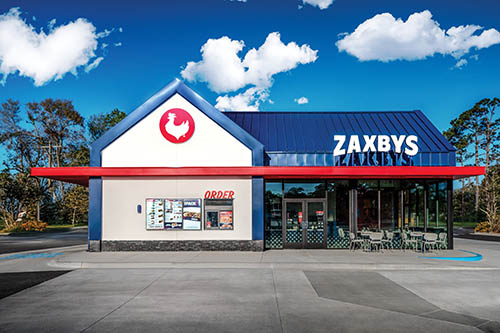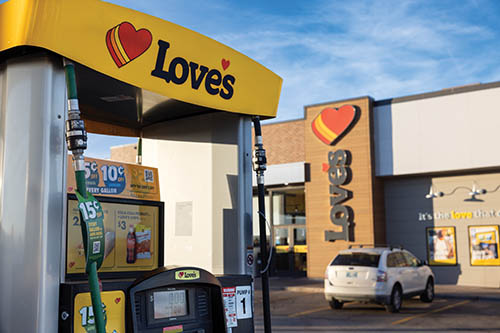— By Katie Lee — Nearing 1,000 locations nationwide, Zaxbys is evolving from a regional Southern favorite to a national QSR staple. As it celebrates its 35th anniversary this year, Zaxbys® has ushered in a new era with a comprehensive refresh. This includes the introduction of its ‘Modern Farmhouse’ restaurant design, as well as an updated visual identity, branding and packaging. Together, these updates reflect a modernized, cohesive look and feel, signaling the next chapter in Zaxbys’ evolution while maintaining the bold flavors and Southern hospitality that guests love. And …
Features
— By Marc Mascarello — How hidden air diffusers are changing commercial interiors. Walk into a beautifully designed restaurant or retail space, and your eyes are drawn to the details — the layered lighting, the textures and materials, the sense of flow and spatial balance. But when HVAC components like air vents or grilles jump into view, they can interrupt that visual harmony in an instant. Mechanical systems are essential to occupant comfort, yet they’re often considered late in the design process or treated as background elements to work around. …
— By Etrit Demaj — Smart tech rewrites the retail maintenance playbook. Retail and restaurant operators have long accepted reactive maintenance as the cost of doing business. When equipment breaks, facility teams respond, often at high cost and with little warning. But this break-fix cycle no longer works in today’s environment of shrinking margins, energy mandates and rising customer expectations. A growing number of multi-site operators are shifting to a proactive, tech-enabled maintenance model that prevents problems, instead of waiting for them to arise. This approach turns building systems into …
Proactive Maintenance: The Key to Avoiding Costly Restaurant Downtime
For restaurants, few things are more disruptive or expensive than an equipment failure during working hours. Whether it’s a failed refrigerator, a backed-up drain or an HVAC unit that quits in the height of summer, a single breakdown can halt operations, spoil inventory, drive away customers and result in lost revenue and trust. Yet most of these expensive emergencies can be prevented through proactive maintenance. “Regular inspections and cleaning schedules are the simplest way for restaurants to safeguard uptime and extend the lives of their critical systems,” says Bill Schaphorst, …
The Big Chill
— By Ramez Naguib — Exploring the benefits of glycol chillers in restaurants. Glycol chillers are specialized refrigeration systems and often involve the use of antifreeze. A popular application is in beverage production, wherein the food grade chemical propylene glycol is used.i Glycol is not a refrigerant; instead, it is a fluid that is used to carry heat from one location to another in much the same way as a conventional refrigerant does. But, unlike a refrigerant, glycol does not undergo a state change (from a liquid to a gas, …
— By Tom Dawson — The true cost of a roof leak. When most businesses think about the cost of a roof leak, they typically focus on the expense associated with the roofing contractor who comes out and fixes the roof. However, leading brands are beginning to look deeper — quantifying the impact of roof leaks to your organization is not just an issue for the facilities team, but is a challenge that impacts culture, operations and guest experience. For hospitality groups like Brinker International, the impact of a roof …
— By Scott Thomas — Improving security and the customer experience. Artificial intelligence (AI) has been discussed in the physical security industry for years and offers strong potential for retail security automation and management. It may be surprising to discover that many retailers already use some form of AI in their security technologies. Analytics engines process massive amounts of data, such as images, text or numbers — using AI algorithms to produce actionable insights. For example, analytics can automatically flag vehicles linked to previous incidents upon arrival and streamline the …
— By Sandeep Ahuja — Turning vacant big box stores into assets with AI. Redeveloping these stores has always been costly and slow. AI is starting to change that by giving owners and developers faster ways to rethink these large spaces and plan for their next chapter. Big box vacancies can quickly erode the value of an entire shopping center. With AI, owners no longer have to rely on guesswork about what comes next. In one Florida redevelopment, analysis showed how an empty 82,000-square-foot anchor could be repositioned to generate …
— By Lawrence Brown — How Rita’s® is turning former banks and dry cleaners into thriving dessert shops. The retail real estate market is at one of its most challenging points in recent memory. Vacancy rates are low, rents are high and construction costs continue to climb. For restaurants and retailers, those dynamics have turned traditional site development into a steep uphill climb. But for Rita’s® Italian Ice & Frozen Custard, this environment has been a catalyst for creativity and growth. At Rita’s, we’ve embraced adaptive reuse and flexible prototypes …
— Interview by Katie Lee — How Love’s Travel Stops grows its business by listening to customers and keeping their comfort and convenience top of mind. When a company is run with love, it shows. Love’s Travel Stops is more than just the namesake of its founders, Tom and Judy Love, who opened a single filling station in 1964 in Watonga, Oklahoma. Today, this staple of the highway for over six decades remains family-owned and operated. What it has not done is remain complacent: In the modern era, Love’s is …










